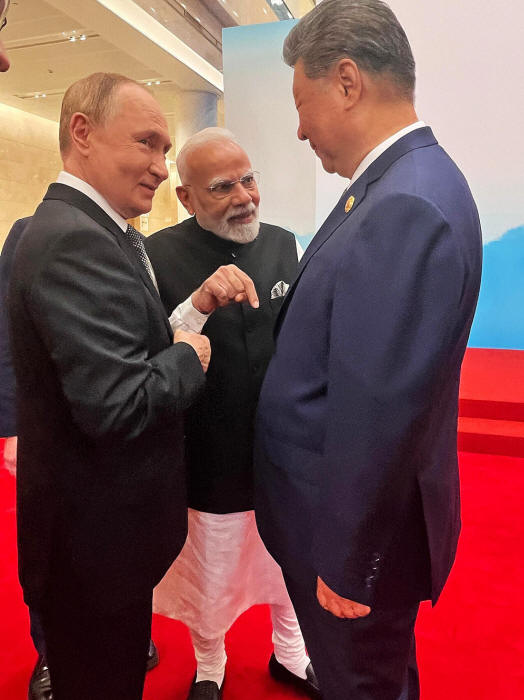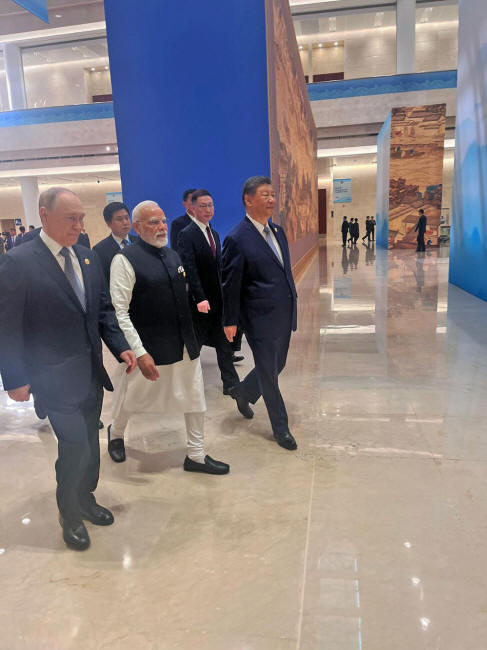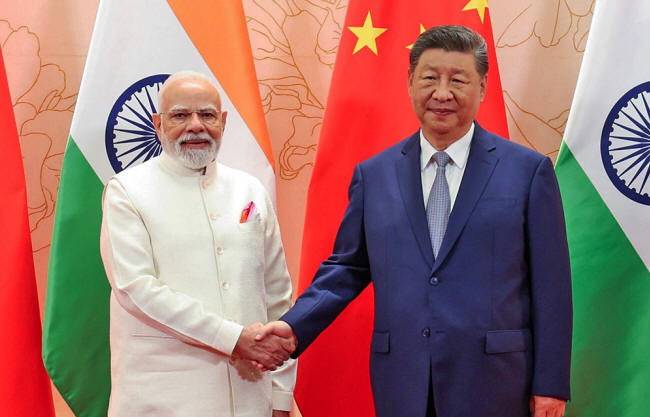|
September 04, 2025
Narendra Modi with Vladimir Putin and Xi Jinping. (GODL-India)
When the leaders of China, Russia, India, and several Central Asian states gathered in Tianjin last week for the Shanghai Cooperation Organization (SCO) Summit, the world should have paid far closer attention.
Collectively,
This is not a peripheral coalition but a core pillar of the
international system in the making.
What unfolded in Tianjin was not just another regional summit.
It was the clearest indication yet that the unipolar world of
U.S. primacy, which dominated the decades after the Cold War, is
giving way to a new and contested multipolar order.
Beyond symbolism, the summit carried substance.
Taken together, they signal that the SCO is evolving from a loose
forum into a framework capable of shaping the rules of the
21st-century world.
Ignoring the SCO or dismissing it as a talking shop risks overlooking the consolidation of an alternative power center that is steadily building legitimacy outside of Western institutions.
For the rest of the world, particularly in
the Global South, Tianjin
served as a reminder that power is no longer concentrated in a
single pole, but dispersed across multiple capitals with diverging
visions of order.
It was a milestone in the slow but unmistakable rebalancing of
global power and a process that will define international politics
for decades to come.
Russian President Vladimir Putin, Indian Prime Minister Narendra Modi and Chinese leader Xi Jinping at the SCO Summit. (GODL-India)
His remarks were not mere diplomatic pleasantries; they were a direct critique of the U.S.-led alliance system and its reliance on deterrence, sanctions, and bloc politics.
Backed vocally by Vladimir Putin, Xi pledged to accelerate
the creation of a
multipolar order in which Western
dominance would be checked by new centers of power across Eurasia
and beyond. [1]
This framework goes well beyond aspirational communiqués:
One of the boldest proposals on the table was the creation of a dedicated SCO development bank that poses an explicit challenge to the Bretton Woods institutions, particularly,
Such a body, if realized, would allow SCO members to finance projects without the conditionalities often imposed by Western lenders.
It would also complement other Chinese-led initiatives such as the
Asian Infrastructure Investment Bank (AIIB) and the
Belt and Road Initiative,
weaving them into a broader Eurasian financial ecosystem.
By offering alternative sources of capital, Beijing and its partners are signaling that the monopoly of Western financial governance is coming to an end.
The SCO's proposed bank would not only fund railways, pipelines, and
fiber-optic networks across Eurasia but also serve as a symbolic
assertion of financial sovereignty.
It is not yet clear how cohesive or durable this architecture will prove, but its mere existence underscores that the world has moved beyond unipolarity.
The battle is no longer over whether the West will be challenged, but over how rapidly alternative institutions can be consolidated, and how effectively they can deliver.
Far from being a peripheral region, the Central Asian republics are becoming the crossroads of Eurasian connectivity and influence.
Trade corridors linking Shanghai to St. Petersburg are facilitating the movement of goods, capital, and people across thousands of kilometers.
Energy pipelines crisscross Kazakhstan, Uzbekistan, Turkmenistan, and beyond, ensuring that the region's vast natural resources flow to both Chinese and Russian markets while integrating it into a broader strategic network.
Meanwhile, digital "Silk Roads" are introducing Chinese standards
for 5G, artificial intelligence, and telecommunications
infrastructure, further embedding Beijing's technological footprint
across the continent. [3]
Moscow maintained traditional security ties and economic leverage,
while
The region's strategic importance was recognized, but its potential
as a hub of independent, multipolar influence remained unrealized.
The implications are profound.
As the SCO continues to consolidate its influence, the region's rising prominence underscores that multipolarity is not merely a distant aspiration:
Unlike conventional trade settlements, which rely on correspondent
banking in U.S. dollars, the electro-yuan would enable real-time,
blockchain-enabled transactions directly between SCO member states,
bypassing traditional financial intermediaries.
If widely adopted, the electro-yuan could significantly weaken the petrodollar system, which has underpinned U.S. financial dominance since the 1970s. The dollar's centrality in global energy markets has long allowed Washington to exert extraordinary influence over international finance and foreign policy.
By creating a credible alternative settlement system, Beijing and
its SCO partners would undermine this leverage, diminishing the
reach of dollar-based sanctions and reducing the United States'
ability to enforce geopolitical objectives through financial
pressure.
A robust electro-yuan network could accelerate the internationalization of China's digital currency, the e-CNY, and provide a model for other nations seeking to hedge against the dollar.
Coupled with SCO-led development projects and cross-border trade
corridors, it represents a deliberate attempt to construct the
"plumbing" of a parallel financial system that operates on terms
favorable to Eurasian partners rather than Western institutions.
If SCO countries begin pricing energy, commodities, and infrastructure projects in yuan rather than dollars, it could reduce demand for U.S. currency reserves, influence exchange rates, and reshape global investment flows.
Commodity markets may see shifts in pricing benchmarks, particularly in oil and natural gas, as the electro-yuan provides a viable alternative to the dollar-based contracts that dominate today.
For investors and multinational corporations, reliance on the dollar
as the default currency for trade and finance may gradually
diminish, introducing new risks and opportunities in hedging,
capital allocation, and currency management.
A system that decouples trade and investment from the dollar would
not only reduce the United States' economic influence but also
recalibrate global alliances, making financial sovereignty a
tangible tool of statecraft for countries like China, Russia, and
their SCO partners.
It is building the infrastructure that could one day rival, and
perhaps circumvent, the very foundations of U.S.-led global economic
power, with consequences that extend to every corner of the global
market.
India's Pragmatic Hedge
meeting with Narendra Modi (GODL-India)
Historically cautious about Chinese-led initiatives, India has often approached regional multilateral frameworks with skepticism, wary of being overshadowed by Beijing or Moscow.
Modi's participation signaled a subtle but meaningful shift in
India's strategic calculus that acknowledged engagement, rather than
isolation which is essential in a rapidly evolving multipolar world.
These steps demonstrate a willingness to separate economic pragmatism from ongoing territorial and border disputes, particularly in regions such as Ladakh and Arunachal Pradesh.
By compartmentalizing these issues, India is signaling that it can
cooperate on economic and regional integration while maintaining its
security concerns.
Instead, it reflects a strategic hedging approach:
By participating actively, India secures a voice in shaping regional
rules and norms rather than remaining a passive observer to a
process that will define the geopolitical landscape for decades.
At the same time, India continues to cultivate robust partnerships through the Quad (with the U.S., Japan, and Australia) and its growing bilateral ties with Washington.
In practice, this means India is simultaneously engaging with China-led institutions like the SCO while strengthening security and technological cooperation with the U.S.-led Indo-Pacific bloc.
This dual-track strategy allows New Delhi to hedge against uncertainty on multiple fronts:
The Tianjin summit thus reflects a uniquely complex Indian strategy:
By balancing its SCO participation with Quad commitments, India positions itself as a pivotal actor capable of bridging competing spheres of influence, maximizing strategic flexibility in an era defined by multipolar competition...
While Washington and Brussels continue to wield significant economic, military, and diplomatic power, their ability to unilaterally dictate global terms is steadily eroding.
For decades, Western institutions such as the IMF, World Bank, NATO,
and dollar-based financial systems served as the primary levers of
influence, shaping trade, development, and security outcomes across
the globe.
They seek options that provide economic resilience, infrastructure development, and energy security without the political strings often attached to Western loans or alliances.
From pipelines in Central Asia to digital connectivity projects
extending China's 5G standards, the SCO is offering practical
alternatives that simultaneously advance regional integration and
multipolar governance.
Nations that fail to recognize this realignment risk being left behind not just economically, but politically and strategically.
Participation in emerging trade corridors, digital networks, and financial mechanisms will increasingly define influence in Eurasia and beyond.
For decades, Western primacy framed global debates and set
expectations of power projection.
The West can no longer assume that its preferences will
automatically shape outcomes; influence must now be earned,
negotiated, and, in some cases, competed for.
To remain relevant, Western policymakers must move beyond complacency and recognize that a world with the SCO at its center demands engagement on terms that are increasingly pluralistic, flexible, and contested.
Ignoring this reality is not just shortsighted but a strategic liability.
This is not merely a shift in power, it is a transformation of the architecture of international relations.
Multiple centers of influence such as Beijing, Moscow, New Delhi, and the capitals of Central Asia are actively shaping the rules, institutions, and economic flows that will define the 21st century.
The West, powerful as it remains, is increasingly one participant
among many rather than the default decision-maker.
The Tianjin summit, however, signaled that the next chapter will be written differently.
The SCO is not simply a forum for dialogue; it is a deliberate effort to institutionalize an alternative framework for regional and global governance, encompassing trade, energy, technology, and finance.
From the expansion of the yuan in energy settlements to
infrastructure corridors across Central Asia, the SCO is
constructing the material and institutional foundations of a
multipolar order that can operate independently of Western-led
institutions.
Crucially, multipolarity is not zero-sum since it does not necessarily mean confrontation, but it does demand recognition that influence, leverage, and legitimacy are now dispersed.
States and institutions that cling to a unipolar mindset may find
themselves increasingly marginalized, while those capable of
engaging with multiple power centers, hedging risks, and
participating in alternative frameworks will thrive.
The SCO, with its blend of economic initiatives, security coordination, and financial innovation, illustrates that the 21st century will be defined by complexity, interdependence, and competition among multiple poles of power.
The central question now is whether the West will acknowledge and
adapt to this new reality or allow others to shape the future on
their own terms.
Notes
|




